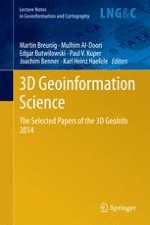2015 | OriginalPaper | Chapter
Requirements on Building Models Enabling the Guidance in a Navigation Scenario Using Cognitive Concepts
Authors : Katrin Arendholz, Thomas Becker
Published in: 3D Geoinformation Science
Publisher: Springer International Publishing
Activate our intelligent search to find suitable subject content or patents.
Select sections of text to find matching patents with Artificial Intelligence. powered by
Select sections of text to find additional relevant content using AI-assisted search. powered by
